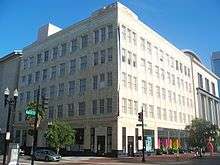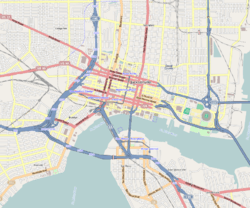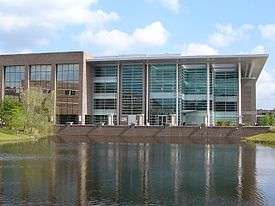Museum of Contemporary Art Jacksonville
 | |
 Location within Central Jacksonville | |
| Established | 2003 |
|---|---|
| Location |
333 North Laura Street Jacksonville, FL 32202 |
| Coordinates | 30°19′46″N 81°39′31″W / 30.329319°N 81.658649°W |
| Type | Art museum |
| Director | Marcelle Polednik [1] |
| Public transit access |
Bus: Riverside Trolly Northbank Line Southbank Line |
| Website |
Building details |
| Former names | Western Union Telegraph Building |
| General information | |
| Architectural style | Art Deco |
| Completed | 1931 |
| Owner | University of North Florida |
| Design and construction | |
| Architect | Marsh and Saxelbye |
| Developer | Western Union Telegraph Company |
The Museum of Contemporary Art Jacksonville, also known as MOCA Jacksonville, is a contemporary art museum in Jacksonville, Florida, funded and operated as a "cultural resource" of the University of North Florida. One of the largest contemporary art institutions in the Southeastern United States, it presents exhibitions by international, national and regional artists.
History
MOCA Jacksonville was founded in 1924 as the Jacksonville Fine Arts Society,[2] the first organization in the Jacksonville community devoted to the visual arts. In 1948 the Museum was incorporated as the Jacksonville Art Museum, and in 1978 it became the first institution in Jacksonville to be accredited by the American Alliance of Museums.
In late 1999 the Museum acquired its permanent home, the historic Western Union Telegraph Building on Hemming Plaza, adjacent to the newly renovated City Hall, and became the Jacksonville Museum of Modern Art (JMOMA). In 2000, a series of preview exhibitions opened in a temporary exhibition space while the building facade was restored to its original Art Deco style. The interior was completely refurbished to house the Museum’s galleries, educational facilities, a theater/auditorium, Museum Shop and Café Nola. Total renovation of the 60,000-square-foot (5,600 m2), six-floor facility was completed in 2003, culminating in a grand re-opening in May of that year.
Growth
After moving to its downtown location the Museum experienced rapid growth in both membership and the size of the permanent collection. The many substantial additions to the collection increased not only its quality, but also its size to almost 800 pieces. After completing a recent review of the current scope of the Museum’s collection and exhibitions, discussions were held regarding the distinctions between modern and contemporary art, as well as the Museum’s mission and vision for the future. It was decided that in order for the Museum to convey a strong sense of identity and purpose to both the community and other art institutions across the country, its name should change. Therefore, in November 2006, JMOMA became the Museum of Contemporary Art Jacksonville.[3]
The Museum continues to be a cornerstone of Jacksonville’s multibillion-dollar downtown revitalization plan.[4] Its exhibitions and programming bring new visitors to the civic core during the day, at night and on weekends. Educational programming includes children’s literacy initiatives and weekend art making classes as well as regular tours, lectures, films and publications for children and adults.
MOCA Jacksonville is an inviting environment in which to learn about the art of our time. Stroll through the permanent collection galleries and view the works of Hans Hofmann, Joan Mitchell, James Rosenquist, Ed Paschke, and other contemporary masters. MOCA Jacksonville’s changing exhibitions feature the works of many contemporary artists working in a wide assortment of media from painting, sculpture, and video. The third floor hosts exhibitions, which rotate approximately every four months, designed to provide insightful, stimulating and educational experiences.
The University of North Florida acquired the museum in 2009 to act as a cultural resource of the university.[5]
Current exhibitions
- Confronting the Canvas: Women of Abstraction
- Project Atrium: Ethan Murrow
Upcoming exhibitions
- Material Transformations
- Photographs from the New York Times Magazine
Past exhibitions
2013
- Art with a Heart in Healthcare
- Project Atrium: Heather Cox
- Kept Time: Photographs by Joseph D. Jachna
- Inside/Out: MOCA's Permanent Collection
- Project Atrium: Sarah Emerson
- Michael Aurbach
- SLOW: Marking Time in Photography and Film
- UNF Student Juried Exhibition
- First Coast Portfolio
2012
- Project Atrium: Ian Bogost
- ReFocus: Art of the 1980s
- Project Atrium: Tristin Lowe
- Annual UNF Art & Design Faculty Exhibition
- In This Moment: Art with a Heart in Healthcare Exhibition
- Rendering Italy: UNF Art and Design Faculty Abroad
- ReFocus: Art of the 1970s
- Project Atrium: Mark Licari
- The Joys of Collecting: Selections from the Eisen Collection
- Rainbow Artists: Art and Autism Across the Spectrum Exhibition
- Carrie Ann Baade: Solar Midnight
- Joe Forkan: The Lebowski Cycle
- North East Florida Scholastic Art Award
- ReFocus: Art of the 1960s
2011
- Tamara Culbert: 2011 Memphis Wood Excellence in Teaching Award
- Project Atrium: Gustavo Godoy
- UNF Art and Design Faculty Exhibition
- Larry Clark: The Tulsa Series
- Shared Vision: The Sondra Gilman and Celso Gonzalez-Falla Collection of Photography
- No Place in Particular: Images of the American Landscape
- Project Atrium: Melanie Pullen
- What a Doll: The Human Object as Toy
- Stranger in Paradise: The Works of Reverend Howard Finster
- What A Doll: The Human Object As Toy
- Rainbow Artists: Art and Autism Across the Spectrum Exhibition
- FUSION: Ceramic Exhibition by the FIRM: Shane Christensen, Brian Jensen, Stephen Heywood, and Michael Schmidt
- Wind Weaver and the Whirling Wheel: A Tale of Wolfbat Romance
- The Art of Seating: 200 Years of American Design
- Chair Installation by Dolf James
- Edge of Your Seat: Design Challenge, a juried student show in conjunction with The Art of Seating
2010
- East/West: Visually Speaking
- UNF Art and Design Faculty Exhibition
- Imagination Squared: A Community Response Project
- Hyperbolic Nature: Plein Air Paintings by Lilian Garcia-Roig
- Tradition Redefined: The Larry and Brenda Thompson Collection of African American Art
- Marilyn Monroe: Life as a Legend
- Looking Forward, Looking Back: Celebrating the Contributions and Careers of Artist/Educators Larry Davis, Mark Howard & Paul Ladnier
- Dan Estabrook: Forever and Never
2009
- Separate Strategies & Common Goals
- Hamish MacEwan: 90 in 09
- Robert Motherwell: Lost in Form, Found in Line
- The Art of Teaching: UNF Faculty Exhibition
- Emergence: Works by UNF Sculpture Students
- Balance and Power: Performance and Surveillance in Video Art
- Jazz Giants: The Photography of Herman Leonard
- Why Look at Animals? Photography from the George Eastman Collection
2008
- Ultra-Realistic Sculpture by Marc Sijan
- Making Marks: Jacksonville Creates
- The Shape Of Things: Selections From The Permanent Collection
- And Further the Dew Drop Falls: Installations by Chris Natrop
- Civitates Orbis Terrarum: Recent Drawings by John Bailly
- Carly, So Far: Photographs by Francie Bishop Good
- Memphis Wood: Jacksonville's First Lady of the Arts
- Contemporary Visions: A Focus on Jacksonville Collections
- Ramen Noodles 2008: Installation by Sang-Wook Lee
- Continental Shifts: The Art of Edouard Duval-Carrié
2007
- Essence and Materials: Works by Minoru Ohira
- Sculptures by Duncan Johnson
- Raddle Cross & Dowsing: Installations by Martha Whittington
- Coherent Structures: Recent Silverpoint Paintings by Carol Prusa
- Valuistics: The Making Of: An Installation by James Greene
- Contemporary Currents: Selections from the Bank of America Collection
- Impermanence: Recent Works by Andrés Michelena
- Keyhole: Constructed Paintings by Todd Murphy
- Second Skins: Sculptural Soundsuits and Tondos by Nick Cave
- Anderson and Low: Athlete/Warrior
2006
- Green Grass/Black Wings: Paintings by Ian Chase
- Time Capsules: Illuminated Works by Jon Davis
- Bloom: Paintings and Constructions by Luis Cruz Azaceta
- Pilgrimages: Large-Scale Drawings by Clive King
- Nature of Elegy: Works by Timothy McDowell
- Flow: Paintings & Installations by Radcliffe Bailey
- Illuminating Space: New Works by Zac Freeman
- Artifacts: Photographs by David Halliday
- Cheerleaders, Bodybuilders and Disco Queens: Photographs by Brian Finke & Morten Nilsson
- Sheltering Eye: Selections from the Prentice and Paul Sack Photography Collection
2005
- That's Another Story: Works by Ke Francis
- 30th Parallel: A Convergence of Contemporary Painting featuring Radcliffe Bailey, John Bailly, Jim Barsness, Luisa Basnuevo, Mark Messersmith, Rocio Rodriguez, Lynne Ridings, Barry Sparkman
- Transitions: Sculptures and Prints by Joe Segal
- Activating Space: Sculpture as Environment featuring Tim Curtis, David Geiser, George Long, Jeffery Loy & Joe Martin, Michael Murrell, Jimmy O'Neal
- Tonya Lee: New Works
- Shared Vision: Photographs of Baracoa, Cuba – A Collaborative Documentary
2004
- Mark Sain Wilson: Photographs
- Image & Energy: Selections from the Haskell Collection
- Pam Longobardi: World within Worlds
- Push Play: Redefining Pop featuring Ray Azcuy, Didi Dunphy, David Isenhour, J. Ivcevich, Federico Uribe
- Arnold Mesches: A Painting History 1940-2003
- Fruition: New Works by Sarah Crooks Flaire
2003
- David Crown: Mezzotints
- Subject/Object: Photographs by Jay Shoots
- Intuition & Response: Masterworks from the Edward R. Broida Collection
- Jonathan Lux: New Paintings
- High Tide: Works by Joe Walters
- Woody Cornwell: New Paintings
- Skin: Contemporary Views of the Body featuring Magdalena Abakanowicz, Sebastian Blanck, Connie Imboden, Pam Longobardi, Rona Pondick, Terry Rodgers
- The Consuming Image: New Painterly Pop featuring Alisa Henriquez, Ales Bask Hostomsky, James Mahoney, Chris Peldo, Michael Thrush, David Williams
2002
- Alt.Photo: Redefining Process featuring Linda Broadfoot, Thomas Hager, Paul Karabinis, Dominick Martorelli
- Contemporary Regional Sculptors featuring Nofa Dixon, Bob Kirk, Jan Tomlinson Master, David Royal Olson
2001
- Neobotanica: Flora by Four Contemporary Artists featuring David Collins, David Geiser, Timothy McDowell, Barbara Rogers
- American Beauty: Sculptures by Jack Dowd
- Towards the Organic: Material and Metaphor featuring Karen Rich Beall, Tim Curtis, Celeste Roberge
2000
- Image Electric: The Work of Richard Heipp
References
- ↑ http://mocajacksonville.unf.edu/mission-and-history/
- ↑ http://www.floridadesign.com/web/issues/14_2/pr/jacksonville/1.asp
- ↑ http://www.jacksonville.com/tu-online/stories/110906/met_6104435.shtml
- ↑ http://www.flheritage.com/services/magazine/index.cfm?action=article&season=04summer&article=79
- ↑ http://www.artinfo.com/news/story/28818/university-of-north-florida-to-acquire-jacksonville-moca/
